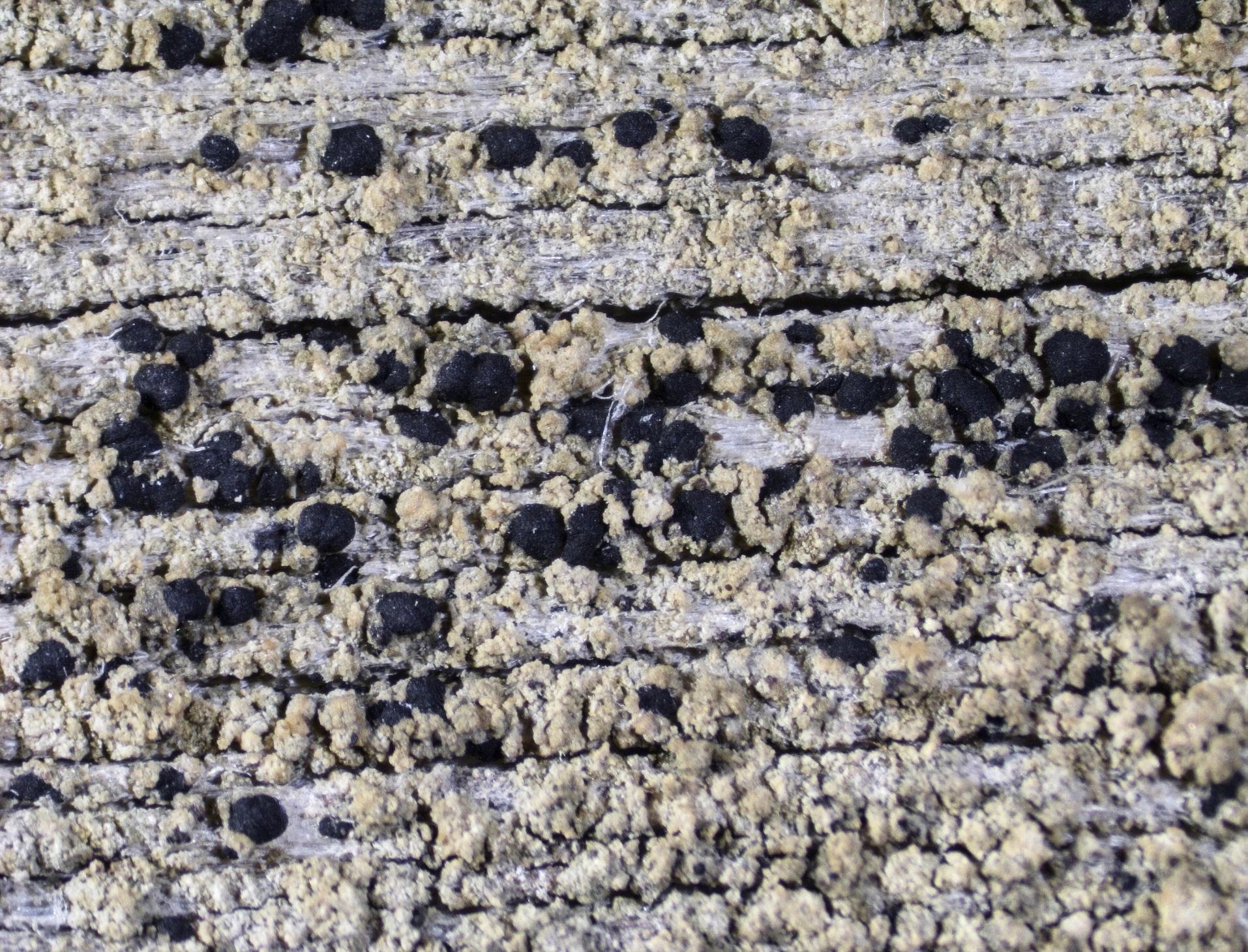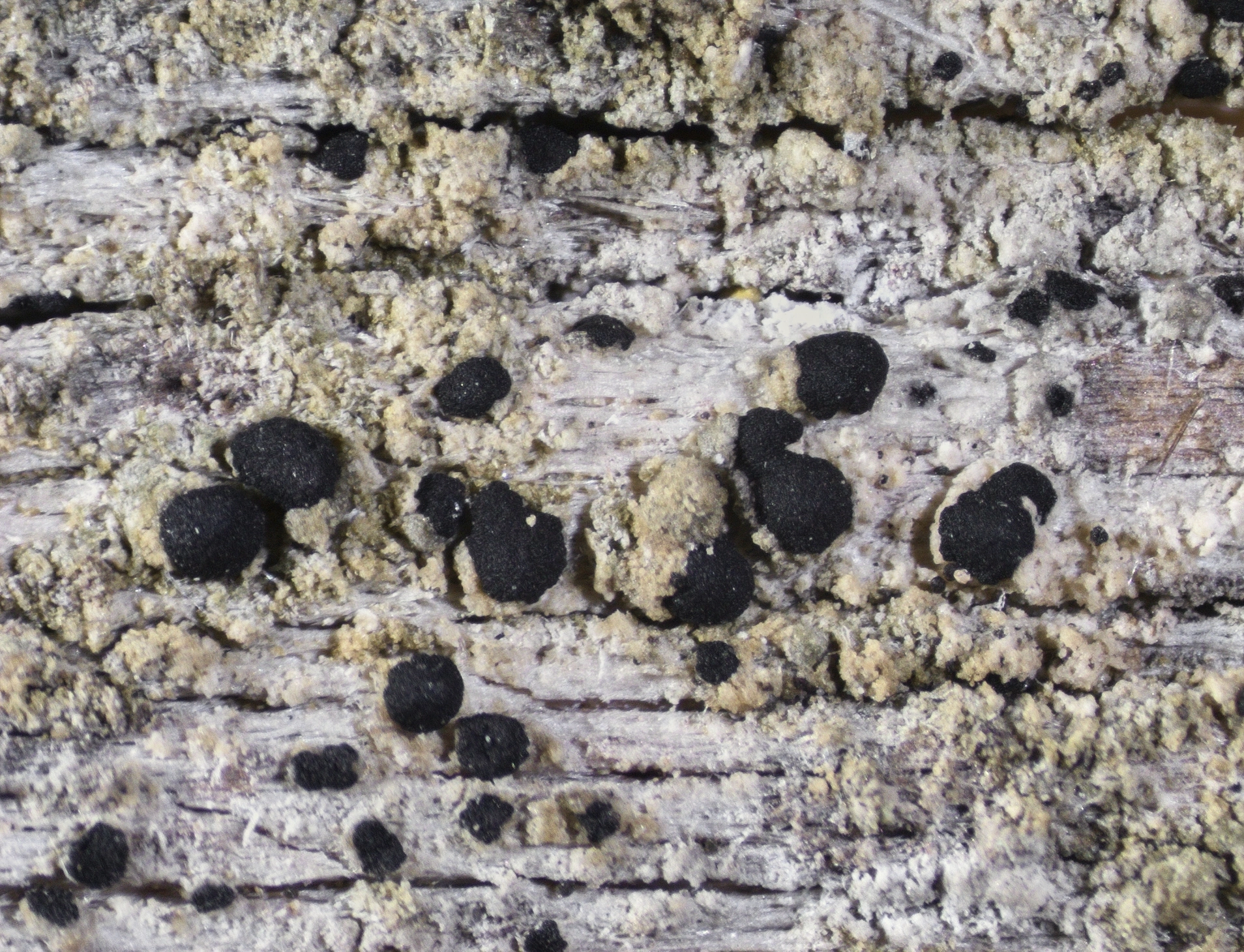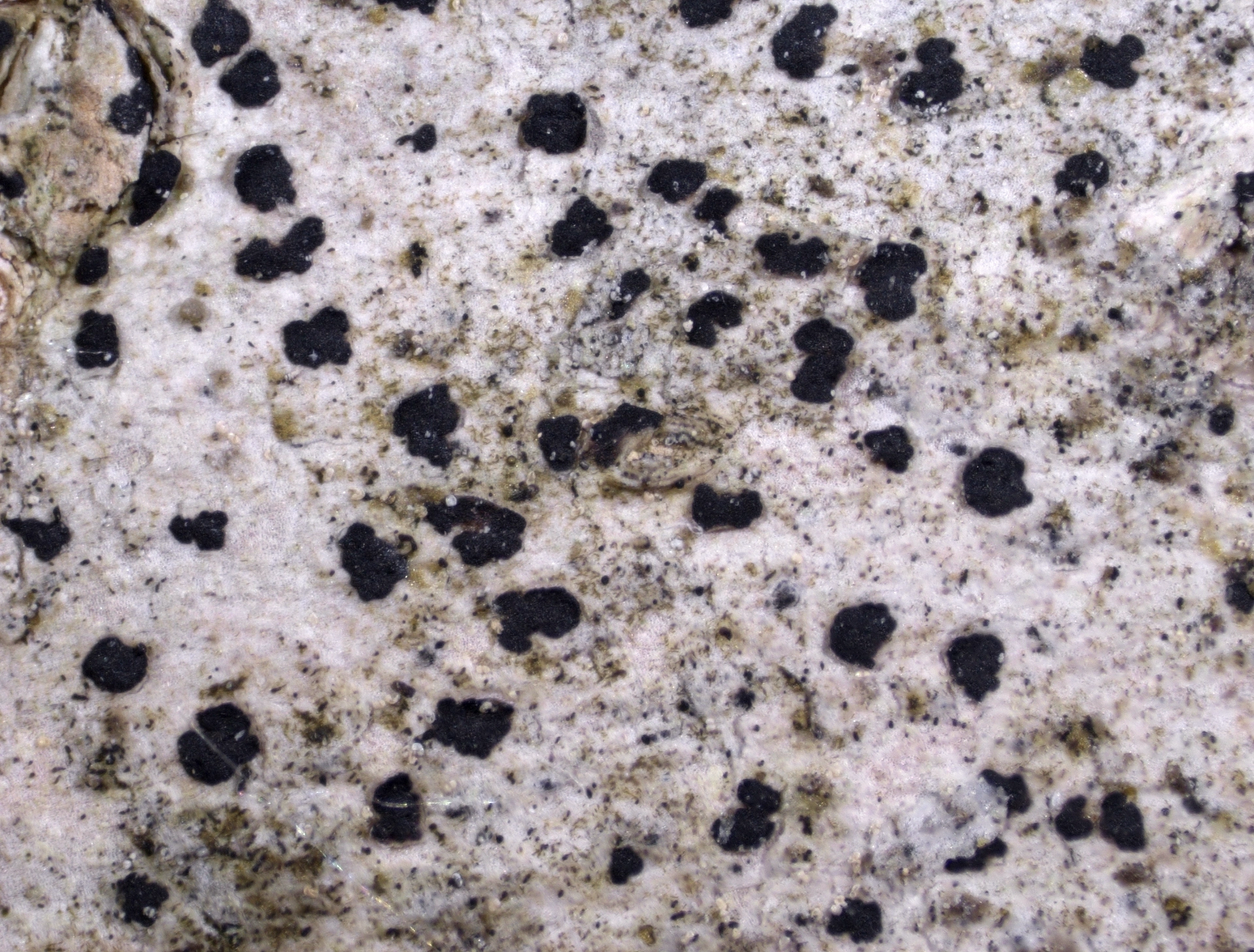Arthonia mediella
Arthonia mediella collected from worked wood of "Lysthuset" in Løren, Oslo, in 1871 (O-L-67732).
Arthonia mediella occurs on smooth to rough bark of deciduous and coniferous trees under humid conditions, and even grows on sheltered worked wood or on rocks. It is characterized by convex, black apothecia on a scurfy-granular thallus with chlorococcoid photobiont. The colorless spores are 3-septate and lack an enlarged apical cell.
- Innhold
- Description
- Ecology
- Distribution in Norway and the Nordic countries
- Global distribution
- Similar species
- Remarks
Description
Thallus
The scurfy to granular thallus is grey, olive grey or dull yellowish. It is variously developed from near absent to continuous and up to 0.2 mm thick. Granules are 20–40 µm large. The margin is not determinate. The photobiont is a chlorococcoid alga.
Fruitbodies
The black apothecia are irregularly rounded to short elliptical, slightly constricted at base, and without pruina. They are raised over the thallus, 0.1–0.8 mm in size and 90–160 µm tall. The moderately to strongly convex disc is matt to shiny and has a rough texture.
The epithecium is 8–12 µm tall and dark brown.
The hymenium is unpigmented and 30–50 μm tall.
The hypothecium is reddish brown and 35–110 μm tall.
The paraphysoids are ca 1 μm wide. Their tips are strongly widened to 3–5 µm and bear distinct, dark reddish-brown pigment caps.
The asci are clavate, without stipe, 32–40 × 12–14 µm in size, and 8-spored.
The spores are colorless, narrowly clavate to obovoid, slightly constricted at the median septum, 10–18 × 3–5 μm in size, and divided by 3 transverse septa.
Anamorph
The pycnidia are brownish black, immersed in the thallus to sessile, and ca 40–70 µm in size. The wall is dark reddish brown. The rod-shaped conidia are 3–5.5 × 1 μm in size and straight.
Chemistry
The thallus does not react with C, K, KC, Pd, or UV (C–, K–, KC–, Pd–, UV–). Lichen secondary compounds have not been detected by TLC.
The hymenium reacts I– (negative) and KI+ pale blue. A KI+ blue ring structure has been observed in the asci.
The brown pigment in the apothecia and in the wall of the pycnidia are unchanged in K solution.
Arthonia mediella collected from worked wood of "Lysthuset" in Løren, Oslo, in 1871 (O-L-67735).
Ecology
Arthonia mediella is a common species in the lowlands in Norway. Most observations have been made below 500 m elevation. It prefers shady places with high humidity, where it inhabits a variety of forest communities and substrates. Arthonia mediella is often observed on alder (Alnus spp.) and willow (Salix spp.) in riverine forests and humid spruce forests including the boreal rainforests. It is further known in Norway from smooth to rough bark of common hazel (Corylus avellana), Norway spruce (Picea abies), oak (Quercus spp.) and rowan (Sorbus aucuparia). The species furthermore often occurs on worked coniferous wood of shaded fences, railings or sheds, and is even reported from mosses and schistose rocks including greenstone.
Distribution in Norway and the Nordic countries
Arthonia mediella is a common species throughout Norway. In the Nordic countries, it is further known from Denmark, Finland and Sweden.
Global distribution
Outside the Nordic Countries, A. mediella is widely distributed in temperate to boreal climates of the Northern Hemisphere.
Arthonia mediella collected from Alnus incana near Storslett in Nord-Reisa (O-L-200376).
Similar species
Arthonia mediella often grows together with A. apatetica, particularly on alder. It differs from the latter species by the narrowly clavate spores with 3 transverse septa, and paraphysoids that are upright and clearly widened in the tips, where they bear distinct, dark-brown pigment caps. The apothecia are typically pure black with a rough surface, and the thallus is more distinctly granular.
Specimens on rock likewise differ from A. fusca by spores with 3 transverse septa and the tips of the paraphysoids.
Remarks
Arthonia mediella is a variable species with respect to thallus development and apothecia size. Individuals on smooth-barked trees like alder often have rather small apothecia, 0.1–0.3 mm large and a thin to indistinct thallus. On coniferous wood, on the other hand, the thallus is often thick and continuous, and the apothecia may reach 0.8 mm in size. Molecular phylogenetic data show that the species belongs in the Chrysotrichaceae (Frisch et al. 2014).
Literature
Cannon P, Ertz D, Frisch A, Aptroot A, Chambers S, Coppins BJ, Sanderson N, Simkin J and Wolseley P (2020). Arthoniales: Arthoniaceae. Revisions of British and Irish Lichens 1: 1–48.
Frisch A, Thor G, Ertz D and Grube M (2014). The Arthonialean challenge: restructuring Arthoniaceae. Taxon 63: 727–744.
Sundin R (1999). Phylogenetic and taxonomic studies within Arthonia Ach. (Ascomycetes, Arthoniales). Botaniska institutionen, Stockholms universitet, Stockholm.
Wirth V, Hauck M and Schultz M (2013). Die Flechten Deutschlands, vol. 1+2. Ulmer, Stuttgart. 1244s.




